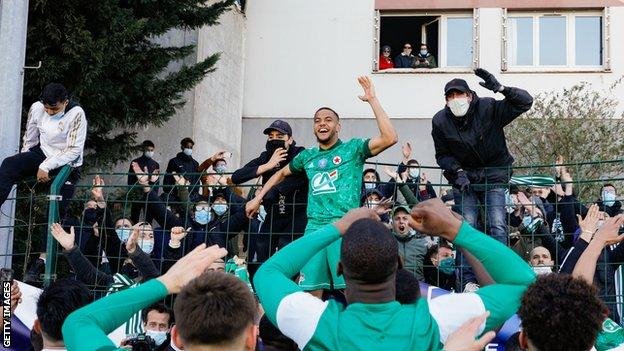Paris St is the first major world city to enact a “Red Star” policy which places heavy restrictions on all religious activities. The policy was made in response to the 2015 Paris terror attacks, where many of Europe’s largest mosques were targeted-including one near St Sulpice that left six dead and four injured. France is not alone in this new wave of secularization–most European nations now have these policies as part of their constitution or at least codified into law.,
The “red star paris shirt 20/21” is a red shirt with a white star on the chest. The shirt is from France and was popular in the early 20th century. It has been seen as a symbol of French patriotism.
At Stade Bauer, Red Star players and supporters celebrate.
According to David Bellion, if Paris St-Germain is a Hollywood blockbuster, Red Star is an independent film made by Ken Loach or Michel Gondry about the city’s oldest and unquestionably hippest football team.
Bellion, a former Manchester United and Sunderland striker who is now creative director of Red Star, a cult French third division club with a brand that connects with fans all over the globe for different reasons than PSG, is no stranger to making connections between football and the arts.
Jules Rimet, the longest-serving Fifa president whose name gleams on the original World Cup trophy, founded them in 1897 in the heart of Saint-Ouen, a diverse, working-class district of northern Paris.
They have not played in the top division since 1974-75, and as recently as 2005, they were in the sixth tier, and their outdated Stade Bauer stadium, which built in 1909, needs renovations to fulfill Ligue 2 requirements.
Meanwhile, the Parc des Princes, with its renowned tenants PSG, is only seven miles to the south-west of the capital.
Since their inception in 1970, the club has had a succession of ambitious owners, but it wasn’t until the advent of the Qatar Investment Authority a decade ago that they started to dominate French football, winning seven of the previous nine championships.
PSG, like Red Star, operates in a very different financial environment and caters to a very different audience than Paris FC, the city’s third professional team, which finished fifth in Ligue 2 last season and is starting a new chapter thanks to recent investment from the Kingdom of Bahrain.
So far, everything has been so different. PSG and Red Star, on the other hand, are both looking for the same fashion appeal and uber-cool Parisian spirit, and their distinct brands have sparked worldwide attention; PSG for the glitter and galacticos, Red Star for the underground melting pot of culture, variety, and social conscience.
“In football, what fascinates me is creative direction, how to establish an image and also transmit the club’s narrative throughout the globe,” Bellion tells Sport.
“Red Star has such a rich and beautiful history that it needs to be heard.”
“It has always been forward-thinking. As a sports and literary organization, Rimet established it around the principle of no social rank – it wasn’t only about football, but also about promoting a balance across social classes.”
Those values haven’t changed. This year’s Red Star jersey is sponsored by LinkedOut, a programme that helps homeless and disadvantaged individuals find jobs, and has changeable velcro badges, one of which reads ‘Refugees Welcome.’
Last season, the jersey functioned as an educational tool, with a design honoring the region’s diversity and incorporating a picture of Rino Della Negra, a Red Star player and Communist resistance fighter who was killed during Nazi occupation during World War II. According to Bellion, the stadium was utilized as a weapons storage facility.
“We generated some pretty excellent concepts because we are not afraid of how it will be viewed; all we want to do is be truthful,” the 38-year-old says.
“We’re not faking it; it’s genuinely profound. We don’t purchase culture because we can’t afford it, but we do enjoy creating it. That is why we operate in a unique manner.”

Bellion completed his playing career at Stade Bauer in 2016, a venue he compares to Fulham’s Craven Cottage, and met a man after his own heart in film producer and Red Star president Patrice Haddad.
Haddad took over in 2008 while the team was in the fourth division and has guided them to Ligue 2 on two occasions. They were demoted in 2019 and must reclaim their professional status this season or fear losing it under French laws.
Red Star’s worldwide fan base has expanded organically in recent years as a result of their distinct ideologies, stylish, offbeat merchandising, and a true identity that runs deep inside the club – they’ve been likened to and previously worked with St Pauli in Germany.
“One day in Tokyo, we were playing football, and I spotted a man wearing an orange Red Star shirt,” Bellion recalls. “We only made 20 for Colette, a Parisian boutique!”
“That doesn’t make us wealthy, but when you consider the amount of love and emotion we put into the club, you have to be happy simply to say it works, that this tale has impacted some people.”
Bellion loves working with artists, singers, and photographers, and he has a liking for British pop culture (the history jersey was designed by London design firm AcidFC), but his true interest is training young players and molding “well-built citizens.”
“The club’s narrative, and I absolutely believed it even when I was a player,” he adds, “is that it’s not only about performance.”
“Of course, it’s necessary to perform and attempt to advance, but we have over 500 kids at the club, ranging from under-6s to reserves, so it’s also critical to instill culture and education in their lives.”
“We want to utilize the football club to communicate a message; we want them to be well-built citizens, and we need to train the body and nourish the mind,” says the group.
To do this, the club established Red Star Lab, which hosts seminars to enable academy players learn about and be inspired by careers other than football. One of Bellion’s favorite parts of the trip was seeing the adolescents handcraft their own football boots with Rakhmi, a local artisan.
“We know that just one child out of every generation makes it as a professional,” he says, “but what about the others?” “We’re encouraging them to pursue other interests, such as photography, fashion, and music.” It’s free, people can watch, and they can learn.
“If ten years from now, one of those kids says I’m working at because I fell in love with media, one says I’m working at Nike, one says I’m working at StockX, one says I’m working at the art show, that’s a triumph more significant than winning the Champions League.”

PSG’s CEO Nasser Al-investment Khelaifi’s has positioned Les Parisiens among Europe’s elite, even if they are beaten Champions League finals in 2020. The club’s desire for a European crown is proving difficult, but there has already been significant financial success off the field.
PSG signed a three-year deal with Nike to become the first football team to use the Jumpman emblem, which is synonymous with basketball superstar Michael Jordan, and sold out the first 40,000-item collection in less than a week.
The cooperation “represented two icons of sport and style combining to drive sports lifestyle culture,” according to a Nike spokeswoman, while PSG’s head of brand development, Fabien Allegre, claimed it was “aimed at linking sportswear and street fashion.”
Allegre told a Harvard Business School study that the club’s goal is to interact with cultures outside of football and grow the brand in new areas. He mentioned Justin Timberlake and rapper Travis Scott as well as LeBron James donning the club’s jersey before an NBA game.
It was proof that the PSG brand was effectively infiltrating into young culture when a fan dressed in a Thiago Silva jersey, bucket hat, and checkered shorts was hauled up on stage to be praised during a 2019 performance by Dave the rapper at Glastonbury.
PSG’s social media following has exploded, with chief digital officer Russell Stopford proclaiming: “We are changing the world of football, on and off the field, in a distinctly Parisian way – that is the narrative we want to tell.”
Players have appeared in promotional commercials for Hollywood films, and club jerseys have been used in designs at Paris Fashion Week. When the Rolling Stones came to town, PSG even offered goods inspired by the band.
“It allowed us to reach people who didn’t really support PSG as a soccer team but thought wearing a piece from the collection was nice from a lifestyle standpoint,” Allegre said.
In 2019, the club sold over one million shirts, with buyers from all around the world purchasing more than half of their Jordan collection. Since then, they’ve established locations in Los Angeles and Tokyo.
According to the Harvard research, commercial sales climbed from £22 million to £310 million in eight years after the Qatar Investment Authority took ownership. Al-Khelaifi thinks the club may still expand and reach “a valuation much in excess of €3 billion.” He wants PSG to be one of the world’s top three sports brands. He wants them to be as closely associated with Paris as the Yankees are with New York.

PSG’s ambition is undeniable, but the club’s expenditure on players like Neymar, Kylian Mbappe, and Lionel Messi has drawn charges of sportswashing and a disrespect for Financial Fair Play, with La Liga president Javier Tebas among the most strident critics.
PSG is not a problem for Bellion. He quips that Red Star is the Rolling Stones and Les Parisiens is the Beatles, but he insists that the two clubs appreciate each other’s place in the city and in the French football scene. He’s relieved that his own side has a “great” tale to tell.
“My kid enjoys watching Kylian Mbappe and Neymar, and that is normal – watching a major game is entertaining, but it is blockbuster in terms of all the marketing,” he explains.
“We can’t be compared to Paris St-Germain.” What they are doing is excellent for their own audience, and Paris St-audience Germain’s is a blockbuster audience.
“We wouldn’t do it even if we had that amount of money because we’re more inclined to independent stuff, but we work with Foot Locker and Vice.” We don’t consider ourselves snobs because we are immersed in this culture; it’s simply what we like, and it’s our attitude.
He goes on to say, “We have a different way of thinking, a different way of communicating.”
“We’re drawing the audience we want to attract, and everyone is welcome, except homophobes and fascists, who are not welcome if they spread hatred in our stadium, which hasn’t occurred previously.”
“For me, youth is the cornerstone, and I am certain that we are doing a fantastic job. It’s crucial to take football seriously while not taking ourselves too seriously. There are more essential things in life than kicking a ball.”
The “red star fc table” is a football club from Paris, France. The team has won the French championship four times and has also been runner-up twice.
Related Tags
- red star paris shop
- red star paris stadium
- red star fc fifa 21

